Monday, May 10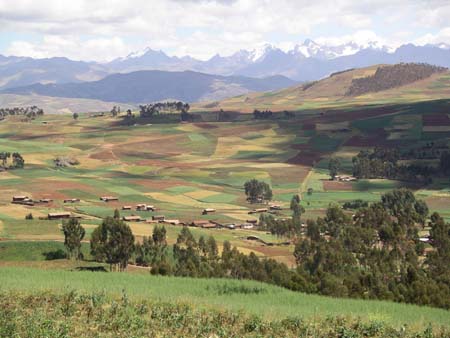
Paula: Another beautiful day in the Andes, more traditional foods, Inca ruins and welcoming Peruvians… Hilda again helped us experience the heart of life in Peru's highlands.
Bright blue skies provided wonderful 360 degree views of the Andes today, allowing us to see complete ranges and numerous glaciers. The rugged mountains serve as the backdrop for a beautiful patchwork of small farms. The fields alternate between shades of green and gold barley, wheat, potatoes and lima beans with an occasional field of lupine in soft lavender. We enjoyed the beauty of the countryside while making our way to Chinchero (population 2,000, elevation 3,763 meters). We have started noting the elevation of our destinations and Hilda has a watch which tells us our elevation wherever we are. Chinchero is actually one of the highest places we've been, explaining why we became very winded several times today (we hope that it's not simply because we are so out of shape…).
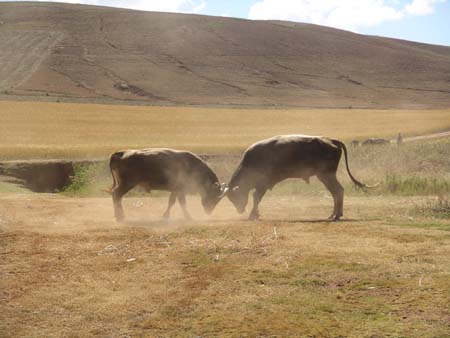 On
our way to Chinchero, we noticed that people were especially busy in the fields.
Whole families were gathered to harvest potatoes and barley. Many of the people
in the Chinchero area were using animal-pulled plows (in addition to the lampa
tools that we had seen being used last week), and Hilda explained that this
was because the soil here is much more difficult to work due to the
On
our way to Chinchero, we noticed that people were especially busy in the fields.
Whole families were gathered to harvest potatoes and barley. Many of the people
in the Chinchero area were using animal-pulled plows (in addition to the lampa
tools that we had seen being used last week), and Hilda explained that this
was because the soil here is much more difficult to work due to the 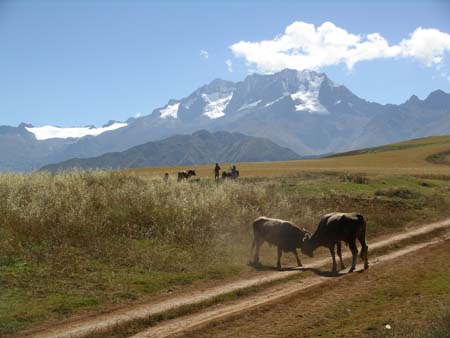 composition
of the clay. We stopped to talk with some locals about the harvest but were
quickly distracted by two bulls engaged in a long and fierce duel. As we looked
on with several of the farmers, the bulls literally had their horns locked
and were violently charging and trying to gore each other. The farmers explained
that these were juvenile bulls and were fighting to establish authority among
the herd. We watched the battle from a distance but at one point found ourselves
having to run back to our van to stay out of their unpredictable path.
composition
of the clay. We stopped to talk with some locals about the harvest but were
quickly distracted by two bulls engaged in a long and fierce duel. As we looked
on with several of the farmers, the bulls literally had their horns locked
and were violently charging and trying to gore each other. The farmers explained
that these were juvenile bulls and were fighting to establish authority among
the herd. We watched the battle from a distance but at one point found ourselves
having to run back to our van to stay out of their unpredictable path.
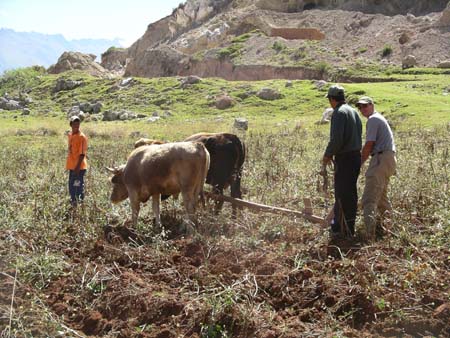 Further
down the road, we stopped to visit with an extended family harvesting their
potatoes. After meeting some of the family members, our offer to help was
quickly accepted. Steve was given an opportunity to plow using two large bulls
tied together by their horns. His job was to guide the plow along the row
of potatoes. It sounded easy enough but he quickly discovered that this work
requires a surprising amount of strength and stamina. After two short rows
of struggling to control the
Further
down the road, we stopped to visit with an extended family harvesting their
potatoes. After meeting some of the family members, our offer to help was
quickly accepted. Steve was given an opportunity to plow using two large bulls
tied together by their horns. His job was to guide the plow along the row
of potatoes. It sounded easy enough but he quickly discovered that this work
requires a surprising amount of strength and stamina. After two short rows
of struggling to control the 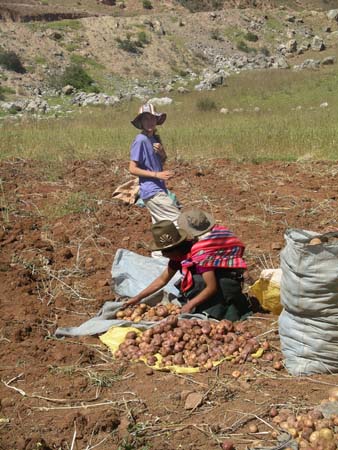 bulls,
he was sweating, huffing and puffing. He was a good sport when the local people
laughed as he struggled to keep the blade of the plow down the middle of the
rows.
bulls,
he was sweating, huffing and puffing. He was a good sport when the local people
laughed as he struggled to keep the blade of the plow down the middle of the
rows.
As we had done last week with the family in Tastayoc, we all spent time here
helping to gather the potatoes that had been unearthed into piles. David and
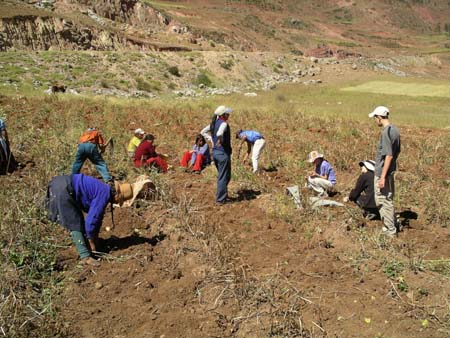 Katie
even heaved the loaded bundles on their backs and helped empty them into bags
that would be used to transport the potatoes to market. Hilda told us that
these potatoes would earn the family only about 12 cents per kilo.
Katie
even heaved the loaded bundles on their backs and helped empty them into bags
that would be used to transport the potatoes to market. Hilda told us that
these potatoes would earn the family only about 12 cents per kilo.
As we worked in the field, we spoke with the family that 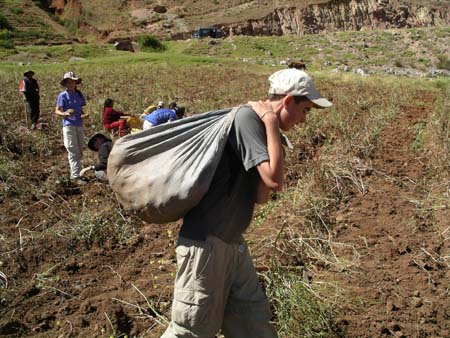 included
several teenage girls who are no longer in school because they have already
started families. Hilda said that this is not uncommon in the countryside.
In fact, in some of the smaller villages the schools only go through the sixth
grade. After learning David's age, this family was quick to ask us if David
included
several teenage girls who are no longer in school because they have already
started families. Hilda said that this is not uncommon in the countryside.
In fact, in some of the smaller villages the schools only go through the sixth
grade. After learning David's age, this family was quick to ask us if David
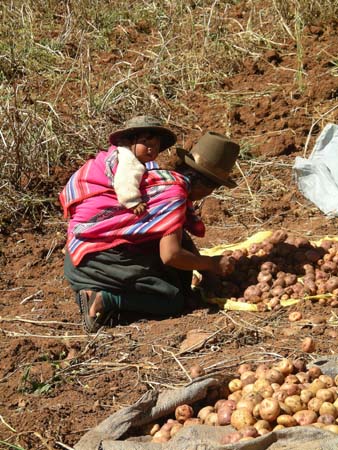 would
be interested in marrying one of the daughters - we laughed realizing that
this is at least the second marriage proposal we have received on his behalf
during our trip!
would
be interested in marrying one of the daughters - we laughed realizing that
this is at least the second marriage proposal we have received on his behalf
during our trip!
This family also had several small children and a baby that was tightly tied
to the back of his mother as she tended a fire. We are always amazed at all
the work that women do with babies on their backs. We have also noticed that
the babies never seem to cry - they obviously love being on their mothers'
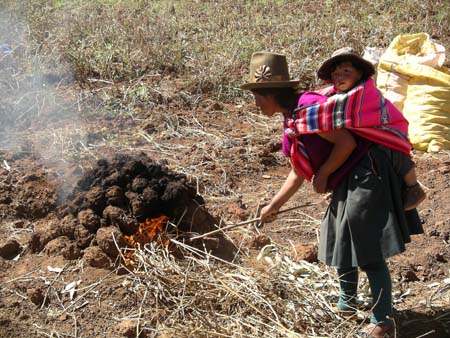 backs.
backs.
The family had just begun their annual potato harvest and was preparing a special feast to "honor mother earth." Once again, we enjoyed watching the preparation for this ceremony. In addition to sharing chicha (fermented corn brew), the family had built a dirt oven during the morning and had been burning dried grass in order to order to bring the soil to the hot temperature needed to bake potatoes. About 100 potatoes had been selected for roasting and these were placed in the oven which was collapsed on top of them. The family planned to eat the roasted potatoes for lunch as part of a traditional harvest celebration. Although we didn't have time to accept their invitation to stay for the feast, the family insisted on offering us some of their chicha and Hilda told us that it was an honor to have been presented the first glass.
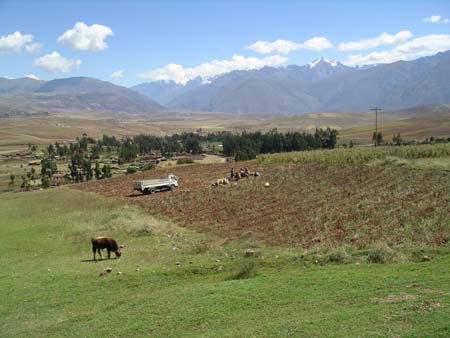
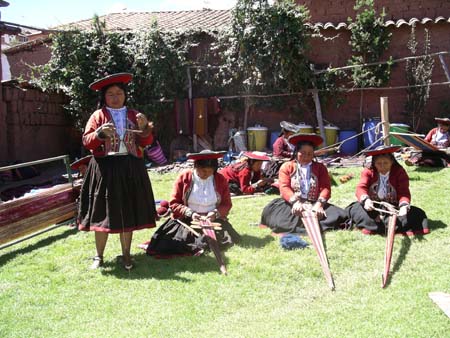
We arrived in Chinchero by late morning. This community is known for producing
excellent textiles and we visited with a local group which is trying to preserve
traditional weaving methods. Here we learned about how the wool is spun, died
and then woven into 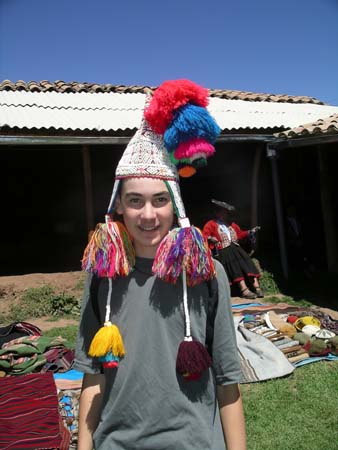 a
variety of textiles used by the local people. We often see women in the villages
spinning by hand, carrying small looms with them to use while they are watching
cattle or resting in the field. Children can learn to spin when they are six
years old but aren't considered capable of the more difficult designs until
they are much older.
a
variety of textiles used by the local people. We often see women in the villages
spinning by hand, carrying small looms with them to use while they are watching
cattle or resting in the field. Children can learn to spin when they are six
years old but aren't considered capable of the more difficult designs until
they are much older.
The designs and colors of the ponchos, hats, and borders are all unique for
each village. We were impressed by the intricate designs that these women
were weaving, and learned that some of the larger articles can take one person
up to three months to complete. We made a few small purchases 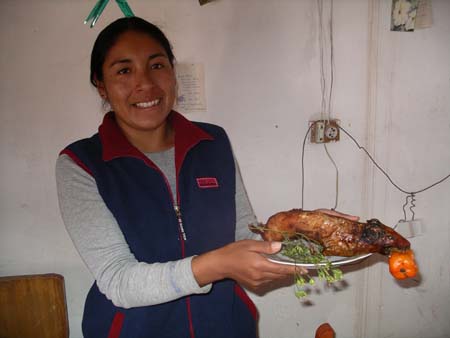 and
Katie received some samples of sheep, llama and alpaca fleece to try spinning
on her own.
and
Katie received some samples of sheep, llama and alpaca fleece to try spinning
on her own.
A special lunch was prepared for us by a family in the village and we had
an opportunity to try several of 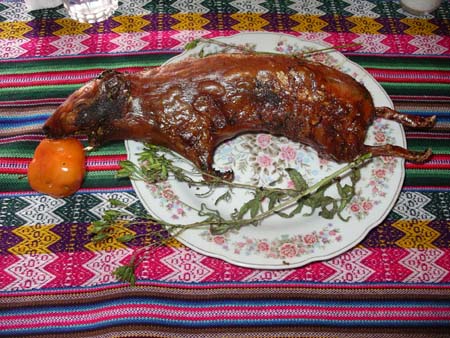 the
local specialties including a variety of vegetables and potato dishes. The
centerpiece of the meal was roasted guinea pig and of course we all had to
give it a try. It didn't "taste like chicken," but had more of a
gamey taste and was actually quite good. We took several pictures of the roasted
guinea pig (presented so beautifully on the plate!), and David insisted on
taking its teeth home as a souvenir. Hilda told us that most visitors don't
even taste the guinea pig, but with all the eating experiences we have had
during our travels, this one didn't faze us at all.
the
local specialties including a variety of vegetables and potato dishes. The
centerpiece of the meal was roasted guinea pig and of course we all had to
give it a try. It didn't "taste like chicken," but had more of a
gamey taste and was actually quite good. We took several pictures of the roasted
guinea pig (presented so beautifully on the plate!), and David insisted on
taking its teeth home as a souvenir. Hilda told us that most visitors don't
even taste the guinea pig, but with all the eating experiences we have had
during our travels, this one didn't faze us at all. 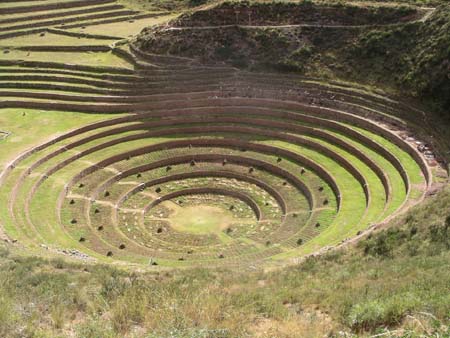
In the afternoon we visited Moray, the site of Inca ruins from the early
15th century. Originally thought to be an amphitheater, more recent excavations
suggest that the site was used for agricultural experiments. The impressive
and deep terraces allowed the Incas to precisely change the microclimate at
each level. We spoke 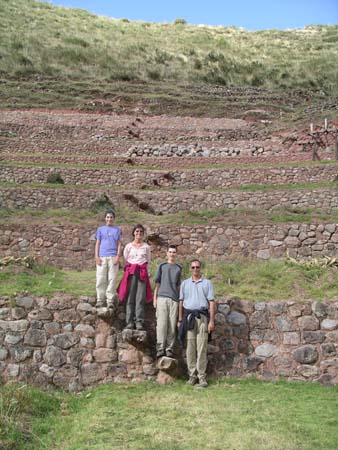 with
some of the INC staff currently involved in excavations and were able to see
how they were slowly digging and exploring each layer.
with
some of the INC staff currently involved in excavations and were able to see
how they were slowly digging and exploring each layer.
The terraces were carefully designed by the Incas to promote drainage and
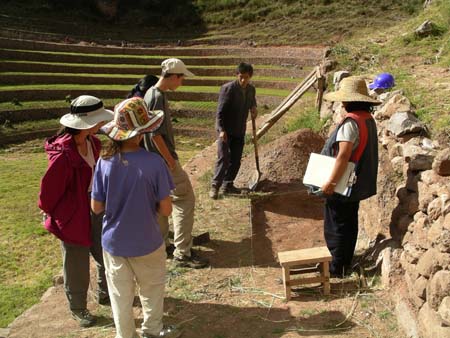 efficient irrigation and contained distinct layers of gravel, sand, clay and
finally topsoil. In addition to water channels, the terraces also have large
rock steps called patapata that were used by the Incas to move from one terrace
to another.
efficient irrigation and contained distinct layers of gravel, sand, clay and
finally topsoil. In addition to water channels, the terraces also have large
rock steps called patapata that were used by the Incas to move from one terrace
to another.
After leaving Moray, we drove through the community of Maras. As we ente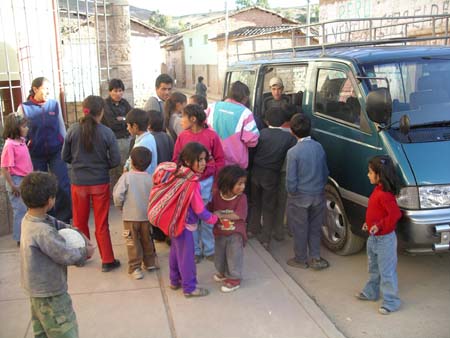 red
this small village, we began seeing many children along its narrow streets.
We stopped the van so that David and Katie could hand out their marbles, pens
and combs to a small group of children. Word spread quickly in the streets
and were quickly surrounded by a much larger group of kids all smiling and
laughing as they waited for their small gifts. As we talked to the children,
we discovered they were coming back to school to rehearse a dance they were
going to perform in an u
red
this small village, we began seeing many children along its narrow streets.
We stopped the van so that David and Katie could hand out their marbles, pens
and combs to a small group of children. Word spread quickly in the streets
and were quickly surrounded by a much larger group of kids all smiling and
laughing as they waited for their small gifts. As we talked to the children,
we discovered they were coming back to school to rehearse a dance they were
going to perform in an u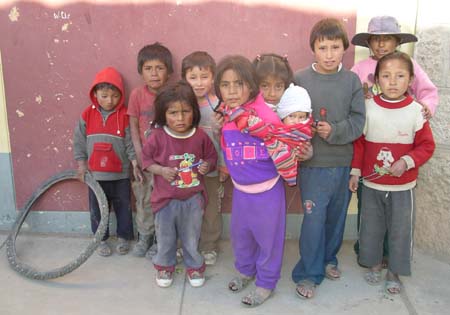 pcoming
harvest celebration. They invited us to watch their rehearsal, and we were
especially impressed by their ability to remember the dance routine which
was over 10 minutes long. We thanked them for their performance before continuing
our trip back to Cusco.
pcoming
harvest celebration. They invited us to watch their rehearsal, and we were
especially impressed by their ability to remember the dance routine which
was over 10 minutes long. We thanked them for their performance before continuing
our trip back to Cusco.
Along the way we headed down a long narrow gravel road which leads into a
deep valley. At the bottom of the valley is a huge salt mine containing hundreds
of pools supplied by an underground spring (the only underground salt water
spring in the Andes). The mine dates back to the Incas, and today the individual
pools are owned by local people from Maras who harvest the 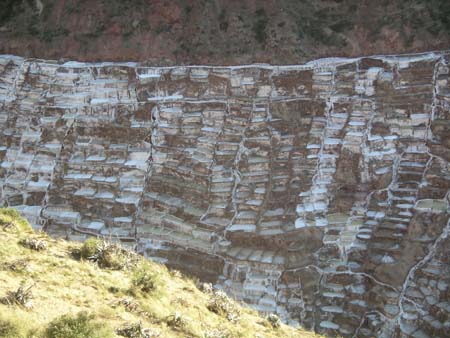 salt
and haul it on their backs up the steep valley.
salt
and haul it on their backs up the steep valley.
Tomorrow we are looking forward to exploring Cusco, the historical capital of the Inca Empire. We will have three days in Cusco before we head southwest to Ica, our last destination in Peru.
